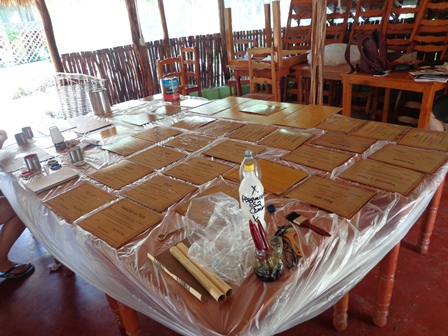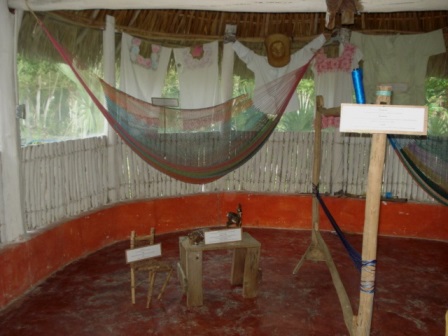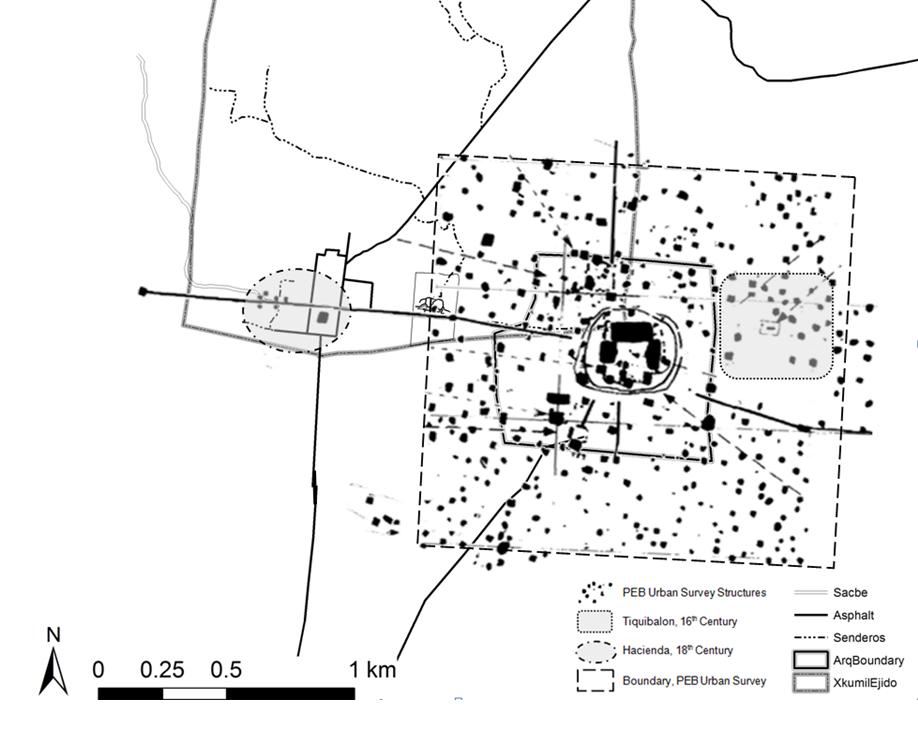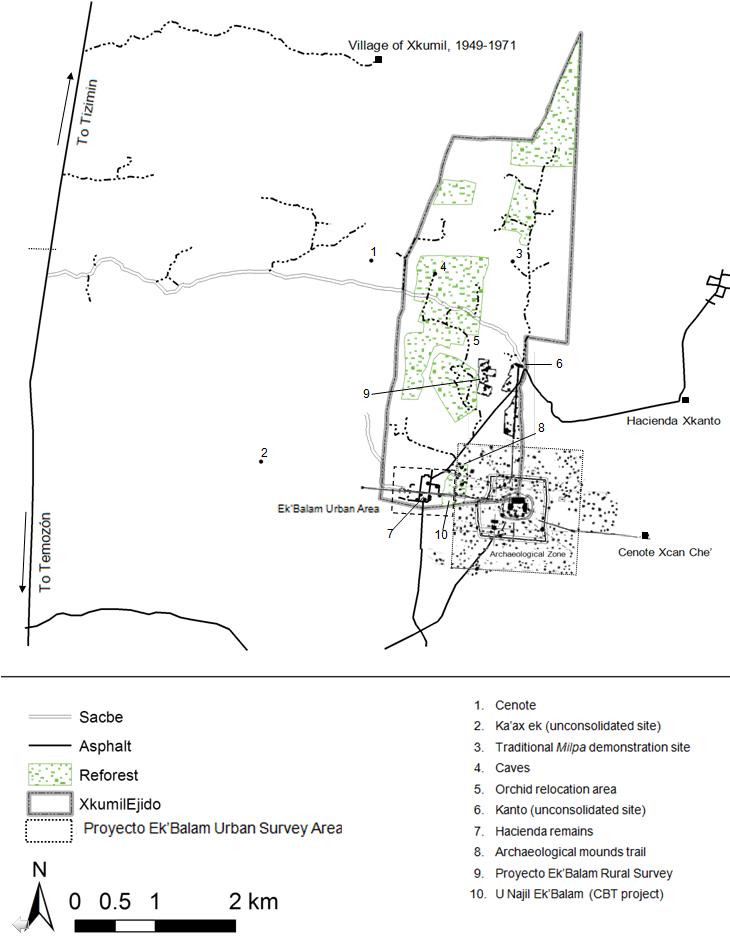 In the summer of 2009, I advised a community museum project as part of that summer’s Conservation Corps volunteer summer camp. The museum would be a traditional Maya house and kitchen. The goal was to incorporate all of the authentic items found in a Maya home, and to accomplish this, volunteers were tasked with asking residents to donate things from their homes. While the concept of the community museum was designed and introduced by CCY, residents played a major role in changing it and shaping the outcomes. The museum was not envisioned as being particularly historical in nature; however, a few older residents participating in the CBT project decided that the history of Ek’Balam needed to be included. Much talk centered on their arrival story, which is a central piece of the historical narrative in Ek’Balam. There was great disagreement about what should be included in the museum to represent a traditional Maya home.
In the summer of 2009, I advised a community museum project as part of that summer’s Conservation Corps volunteer summer camp. The museum would be a traditional Maya house and kitchen. The goal was to incorporate all of the authentic items found in a Maya home, and to accomplish this, volunteers were tasked with asking residents to donate things from their homes. While the concept of the community museum was designed and introduced by CCY, residents played a major role in changing it and shaping the outcomes. The museum was not envisioned as being particularly historical in nature; however, a few older residents participating in the CBT project decided that the history of Ek’Balam needed to be included. Much talk centered on their arrival story, which is a central piece of the historical narrative in Ek’Balam. There was great disagreement about what should be included in the museum to represent a traditional Maya home.  Some men felt that there should be metal pots and utensils, iron hooks, and dishes. They argued that the only modern things that should be excluded were items made of plastic. According to them, this would date the traditional home to approximately the 1960s. Others argued that the home should be “more authentic.” They felt that it should not have metal pots and hooks, and should be appointed in the way of the antiguos (ancient ones), which broadly refers to those who were alive when the monuments were constructed. This group wanted to see a hammock woven of sisal in the museum because the colored nylon thread used today would not have been available then.
Some men felt that there should be metal pots and utensils, iron hooks, and dishes. They argued that the only modern things that should be excluded were items made of plastic. According to them, this would date the traditional home to approximately the 1960s. Others argued that the home should be “more authentic.” They felt that it should not have metal pots and hooks, and should be appointed in the way of the antiguos (ancient ones), which broadly refers to those who were alive when the monuments were constructed. This group wanted to see a hammock woven of sisal in the museum because the colored nylon thread used today would not have been available then.  The most interesting aspect of this process is the diachronic nature of the plans for authenticity. Potential “present-day” for the museum could be at the time that the monuments were occupied, in the 16th century settlement of Tiquibalon, or during the Hacienda era. After substantial deliberation, participants determined that the museum should represent a house from the beginning of Ek’Balam’s current occupation. This would be a house from around 1965-1975, when they began to build up the town in its present location.
In thinking about the space that would be included as part of the community museum, local sentiment determined that it should expand far beyond the walls of the museum itself. Residents were imagining an entire ecosystem of authenticity.
The most interesting aspect of this process is the diachronic nature of the plans for authenticity. Potential “present-day” for the museum could be at the time that the monuments were occupied, in the 16th century settlement of Tiquibalon, or during the Hacienda era. After substantial deliberation, participants determined that the museum should represent a house from the beginning of Ek’Balam’s current occupation. This would be a house from around 1965-1975, when they began to build up the town in its present location.
In thinking about the space that would be included as part of the community museum, local sentiment determined that it should expand far beyond the walls of the museum itself. Residents were imagining an entire ecosystem of authenticity.  The urban area is included along with the rest of the ejido and the archaeological zone. This slide is a map of the key places that are part of this plan. In the south are the urban area of Ek’Balam and the monuments in the ceremonial center of the archaeological zone. Included here as points on the map are the CBT project, the well and hacienda foundation in the center of town, and the ball court. To the north is the rest of the ejido and Hacienda Xkantoh. In the farthest north portion is the abandoned village site of Xkumil. Key points in this region are caves, cenotes, milpas, reforestation areas, and unconsolidated monuments. All told, the map contains features that span time periods from the Terminal Classic period (circa 1000AD) to the present. Residents, however, are ambivalent about assigning periods to the map. They feel that without these designations the map creates a picture of the entirety of Ek’Balam’s heritage.
The urban area is included along with the rest of the ejido and the archaeological zone. This slide is a map of the key places that are part of this plan. In the south are the urban area of Ek’Balam and the monuments in the ceremonial center of the archaeological zone. Included here as points on the map are the CBT project, the well and hacienda foundation in the center of town, and the ball court. To the north is the rest of the ejido and Hacienda Xkantoh. In the farthest north portion is the abandoned village site of Xkumil. Key points in this region are caves, cenotes, milpas, reforestation areas, and unconsolidated monuments. All told, the map contains features that span time periods from the Terminal Classic period (circa 1000AD) to the present. Residents, however, are ambivalent about assigning periods to the map. They feel that without these designations the map creates a picture of the entirety of Ek’Balam’s heritage.